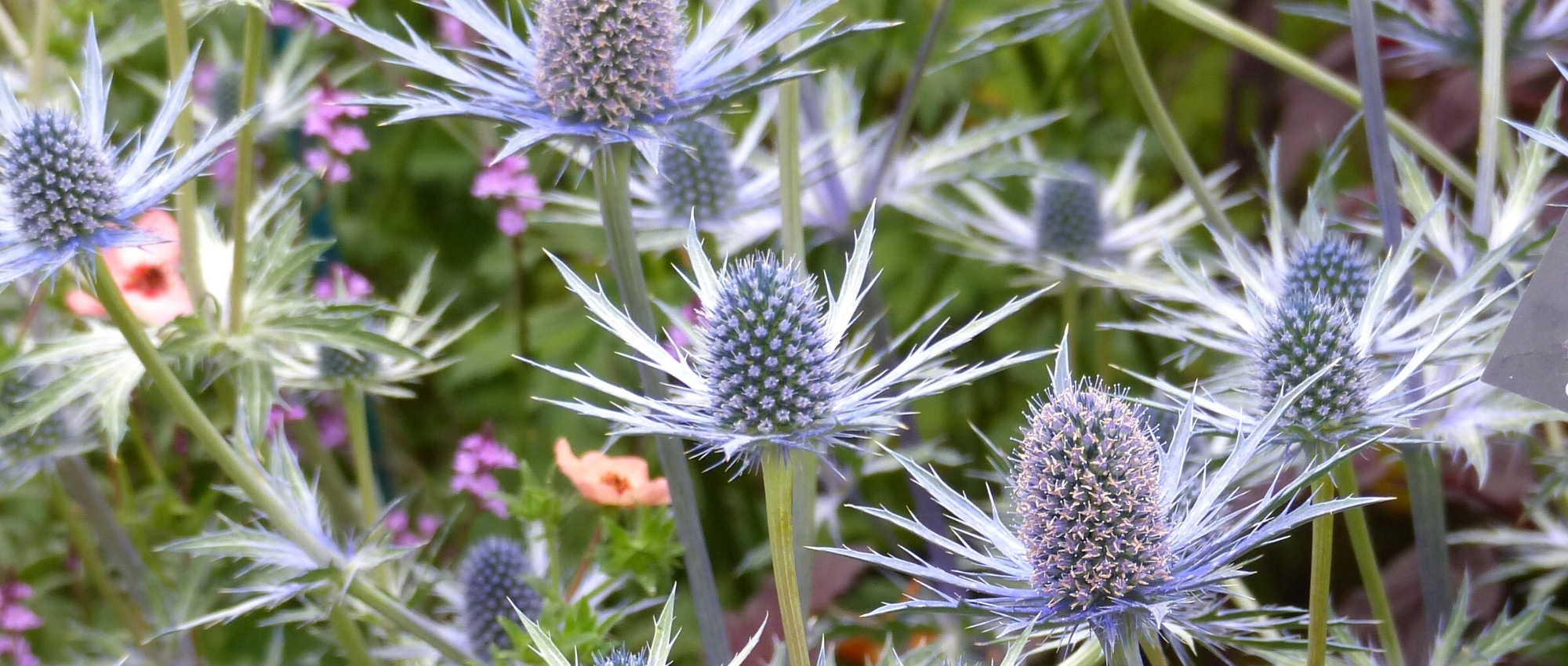
Choosing an Eryngium
According to your desires and your situation!
Contents
Eryngiums, or Sea Hollies, are very graphic and original perennials appreciated for their metallic blue or silver hues. They resemble ornamental thistles, with their rounded inflorescences and thorny leaves. These are easy plants to grow, low-maintenance, and they tolerate drought, sea spray, and poor, stony soils without any issues. They are particularly sensitive to stagnant moisture and easily find their place in a sunny rockery, a naturalistic meadow, or a seaside garden. The most well-known are probably Eryngium alpinum (the blue thistle of the Alps), Eryngium planum, and Eryngium maritimum. However, there are many other species and varieties, making it challenging to know which Eryngium to choose!
Discover all our tips to find the variety that suits your desires and situation.
According to height
Following the different species, the height of Eryngiums is highly variable: they measure between 30 cm and 1.50 m in height… Eryngium pandanifolium can even reach up to 4 m tall! The effect in the garden and the placement reserved for them will therefore vary significantly depending on their dimensions.
The Small Eryngiums
These smaller varieties benefit from being placed at the front of borders or in a sunny rockery.
- Eryngium planum ‘Blue Hobbit’ : with its compact and ramified habit, it does not exceed 30 cm in any direction.
- Eryngium variifolium : this beautiful variegated panicaut does not exceed 40 cm in height.
- Eryngium bourgatii : this is a compact variety, reaching a maximum height of 40-50 cm.
- Eryngium ‘Tiny Jackpot’ : a dwarf variety, ‘Tiny Jackpot’ has short stems that do not exceed 35 cm in height.
- Eryngium maritimum : the sea panicaut forms a clump that measures up to 50-60 cm in any direction.
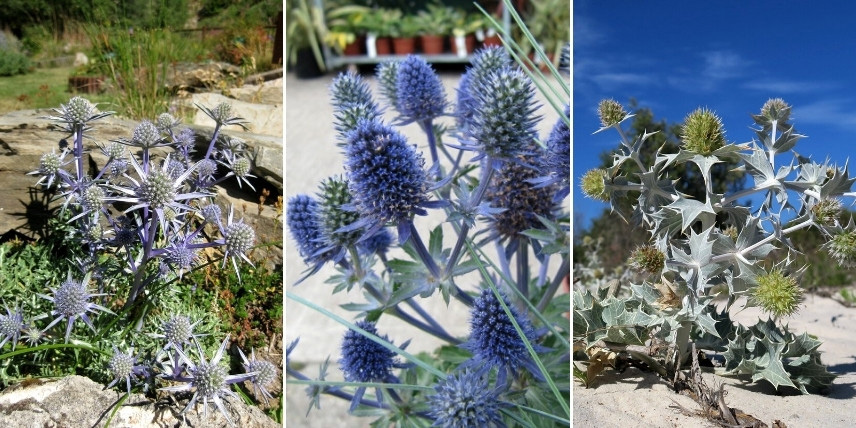 The smallest varieties: Eryngium bourgatii, Eryngium ‘Tiny Jackpot’, and Eryngium maritimum (photos: Carmona Rodriguez / Leonora Enking / Harry Rose)The Large Eryngiums
The smallest varieties: Eryngium bourgatii, Eryngium ‘Tiny Jackpot’, and Eryngium maritimum (photos: Carmona Rodriguez / Leonora Enking / Harry Rose)The Large Eryngiums
The largest Eryngiums can easily be placed at the back of borders, where they will provide structure and volume.
- Eryngium agavifolium : when in flower, it can reach 1.20 m in height, or even up to 1.50 m under ideal growing conditions.
- Eryngium yuccifolium : this panicaut raises its inflorescences to 1.50 m above the ground.
- Eryngium ebracteatum var. poterioides : this eryngium is distinguished by its very light and airy habit, due to its fine, ramified stems that bear inflorescences up to 1.20 m in height.
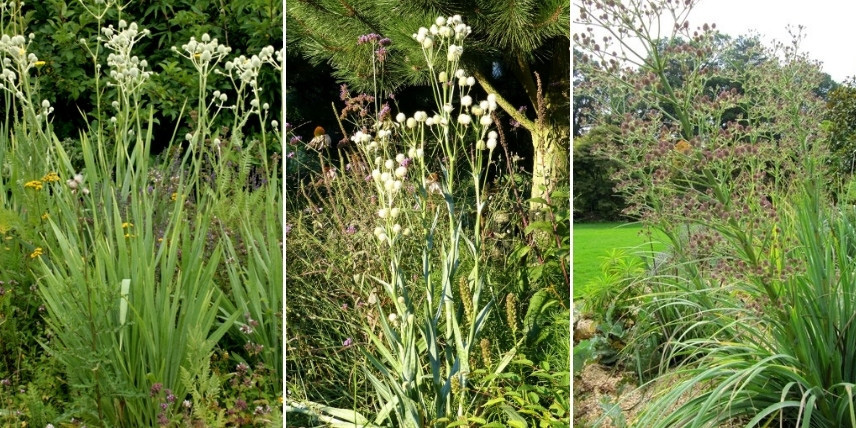 The tallest varieties: Eryngium agavifolium (photo Sten Porse), Eryngium yuccifolium and Eryngium pandanifolium (photo Leonora Enking)
The tallest varieties: Eryngium agavifolium (photo Sten Porse), Eryngium yuccifolium and Eryngium pandanifolium (photo Leonora Enking)
According to the colour and shape of the flower
According to the shape of the flower
Some Eryngiums bear large, highly decorative bracts beneath their flowers. Well-developed and pointed, sometimes finely divided, they give the flower an imposing, majestic appearance. This is particularly true for the following species:
- Eryngium giganteum: its bracts are broad and pointed, majestic.
- Eryngium maritimum: it has sharp, pointed, spiky bracts that are very graphic.
- Eryngium alpinum: its bracts are finely cut, like lace!
- Eryngium ovinum: it offers surprising inflorescences, with fine, pointed bracts scattered among the flowers, giving them a bristly appearance.
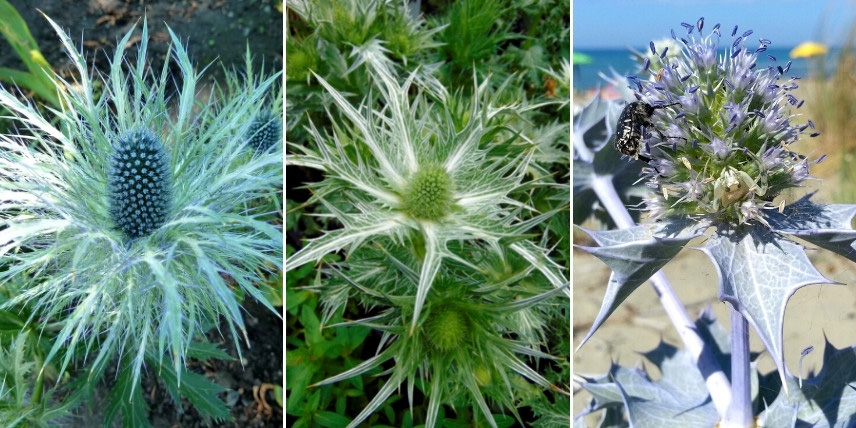 Some Eryngiums have very decorative bracts: Eryngium alpinum (photo Wendy Cutler), Eryngium giganteum, and Eryngium maritimum.
Some Eryngiums have very decorative bracts: Eryngium alpinum (photo Wendy Cutler), Eryngium giganteum, and Eryngium maritimum.
Conversely, other Eryngiums have discreet or non-existent bracts. The flowers then have a much lighter and airier appearance, somewhat like the flowering of Sanguisorbas. These Eryngiums will integrate more easily into naturalistic gardens, with wildflower blooms, grasses, etc.
- Eryngium agavifolium: it offers a discreet flowering, with a very natural style.
- Eryngium ebracteatum var. poterioides: its airy flowering resembles that of Sanguisorbas.
- Eryngium yuccifolium: its white flowering is graphic and delicate.
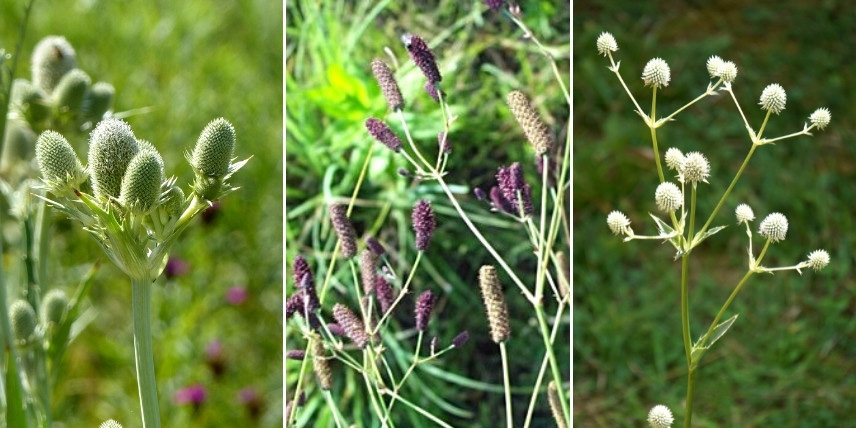 These Eryngiums have very discreet or non-existent bracts: Eryngium agavifolium, Eryngium ebracteatum (photo Andrés González), and Eryngium yuccifolium.
These Eryngiums have very discreet or non-existent bracts: Eryngium agavifolium, Eryngium ebracteatum (photo Andrés González), and Eryngium yuccifolium.
According to the colour of the flower
The flowers come in original shades: they are often metallic blue or silver, but can also be light green or reddish.
- For a silver-white flowering: choose Eryngium giganteum, whose flowers are surrounded by large silver bracts, or Eryngium yuccifolium, which offers a delicate white flowering without bracts.
- For a metallic blue flowering: many varieties offer flowers in this shade. We particularly recommend Eryngium planum (the type species or the variety ‘Blue Hobbit’). You can also choose Eryngium alpinum, Eryngium zabelii ‘Big Blue’, Eryngium ‘Sapphire Blue’, Eryngium ‘Tiny Jackpot’…
- For a less colourful flowering, cream-white to light green: choose Eryngium agavifolium. It offers a very original flowering, with a graphic and natural style.
- For a reddish flowering: opt for Eryngium ebracteatum var. poterioides. Its flowering, without bracts and borne on long upright stems, resembles that of Sanguisorbas. You can also choose Eryngium pandanifolium.
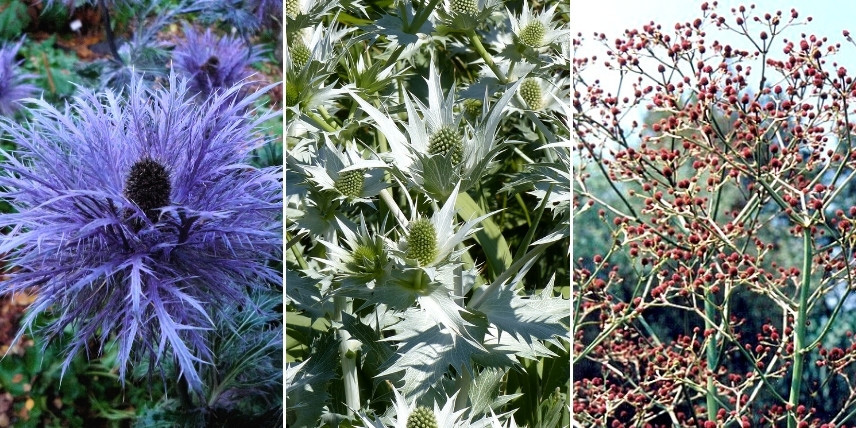 The flowering of Eryngiums can take on different shades: Eryngium alpinum ‘Blue Star’ (photo Jason Eppink), Eryngium giganteum ‘Miss Willmott Ghost’, and Eryngium pandanifolium (photo J.D. Almeida).
The flowering of Eryngiums can take on different shades: Eryngium alpinum ‘Blue Star’ (photo Jason Eppink), Eryngium giganteum ‘Miss Willmott Ghost’, and Eryngium pandanifolium (photo J.D. Almeida).
Discover other Eryngium - Eryngo
View all →Available in 1 sizes
Available in 2 sizes
Available in 1 sizes
Available in 2 sizes
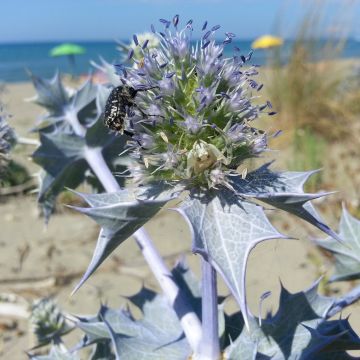
Available in 2 sizes
Available in 1 sizes
Available in 1 sizes
Available in 1 sizes
Available in 2 sizes
Available in 1 sizes
According to the shape and colour of the foliage
According to the shape of the foliage
- The Eryngium pandanifolium, Eryngium yuccifolium, and Eryngium agavifolium form clumps of long, narrow leaves, giving them a very exotic style!
- The Eryngium maritimum, on the other hand, has very short, pointed leaves with sharp edges.
- Also discover the unique Eryngium venustum, with its beautifully cut leaves.
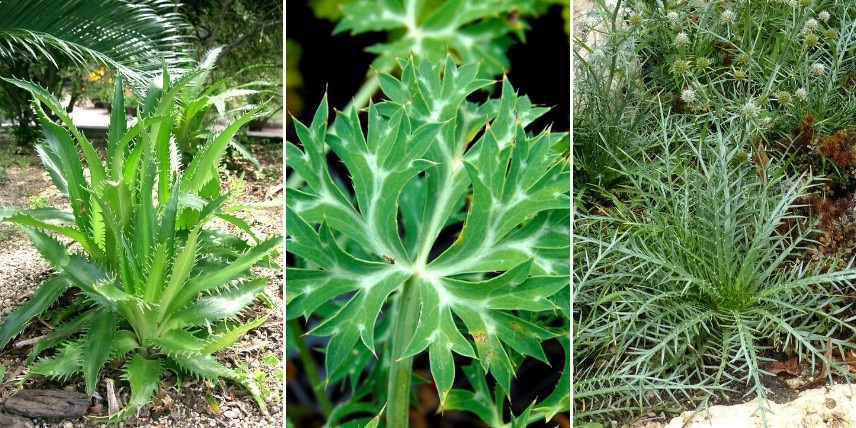
The foliage of Eryngiums varies greatly depending on the cultivated varieties! Eryngium agavifolium (photo Kenpei), Eryngium bourgatii, and Eryngium venustum
According to the colour of the foliage
- For silver foliage: we recommend choosing the Eryngium maritimum
- For variegated foliage: the Eryngium planum ‘Jade Frost’ stands out with its dark green foliage variegated with cream and pink. The Eryngium variifolium has leaves divided into pointed segments, beautifully variegated with white.
- For yellow foliage: we appreciate the Eryngium ‘Neptune’s Gold’ for its very bright, golden yellow foliage!
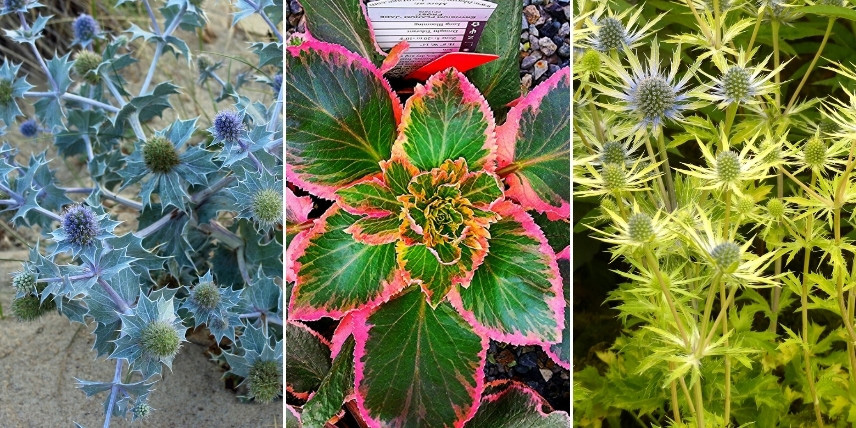
The leaves can also take on various shades! Eryngium maritimum (photo Adobe Stock), Eryngium ‘Jade Frost’ (photo P. Stephen), and Eryngium ‘Neptune’s Gold’
According to hardiness
- The least hardy Eryngiums are those native to South America: these include Eryngium pandanifolium, Eryngium agavifolium, Eryngium proteiflorum, Eryngium ebracteatum, Eryngium eburneum… Their hardiness is often between –7 and –10 °C, but it varies depending on the species, with some being slightly more resilient.
- For good hardiness, choose European species, particularly those that grow in mountainous regions. We recommend, for example, Eryngium alpinum, Eryngium bourgatii, or Eryngium zabelii, which can withstand –15 °C and beyond. Generally, the majority of Eryngiums (except for those from South America) are quite hardy.
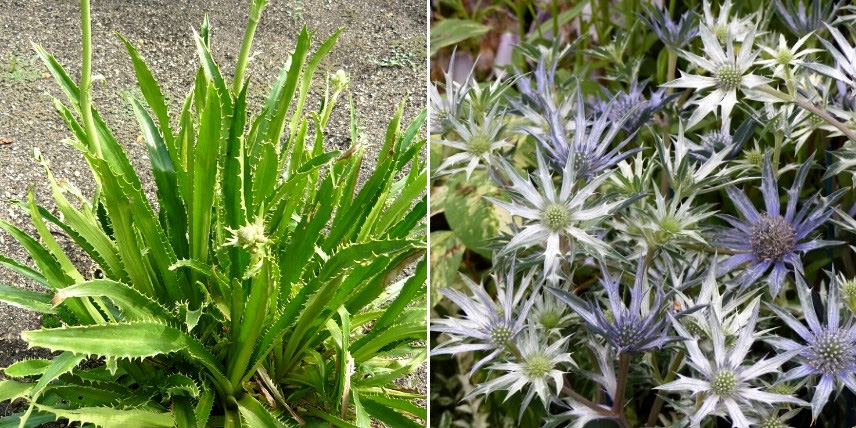 Eryngium agavifolium, on the left, is much less hardy than Eryngium bourgatii
Eryngium agavifolium, on the left, is much less hardy than Eryngium bourgatii
Depending on the use and style of the garden
In a seaside garden:
Naturally growing on coastal dunes, Eryngium maritimum is particularly suited to seaside gardens. It thrives in full sun, on dry, poor, sandy soil, alongside Armeria maritima, Delosperma cooperi, agaves, and grasses.
In an alpine garden:
Some eryngiums are mountain plants and can easily fit into an alpine rockery. For example, choose Blue Alpine Thistle (Eryngium alpinum), Pyrenean Thistle (Eryngium bourgatii), or Eryngium zabelii, which is a hybrid of these two species. Pair them with edelweiss, gentians, saxifrages, and carlines…
In an exotic garden:
The Eryngium pandanifolium and Eryngium agavifolium, native to South America, offer generous foliage with a very exotic style! Combine them with kniphofias, agapanthus, yuccas, and phormiums.
In a graphic garden:
The Eryngium yuccifolium features an original flowering, formed of upright, ramified stems bearing rounded, white inflorescences with incredible graphic appeal! It will easily find its place in a contemporary, graphic-style garden, accompanied by agapanthus, grasses, and bamboos…
In a naturalistic garden:
The Eryngium tripartitum, with its disordered stems and inflorescences that go in all directions, will be perfectly at home in a naturalistic garden. You can also choose Eryngium ebracteatum var. poterioides for this style, whose flowering resembles that of sanguisorbas! Pair these thistles with grasses, knauties, scabious, salvias, gaura, and verbena from Buenos Aires.
- Subscribe!
- Contents
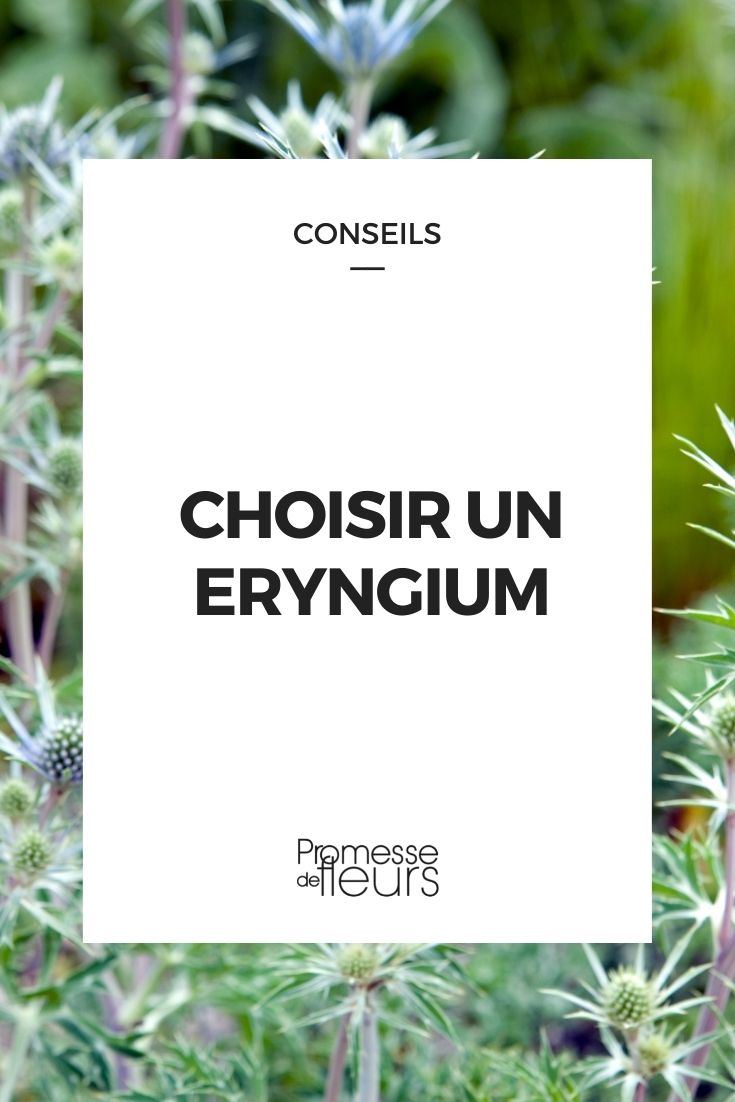































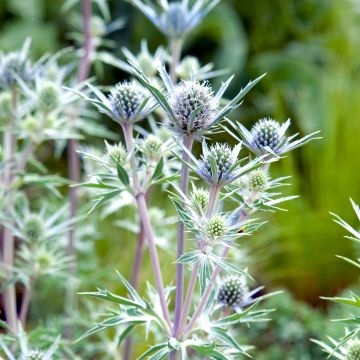
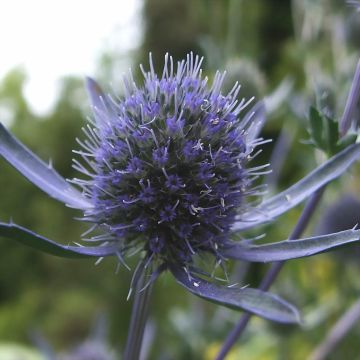
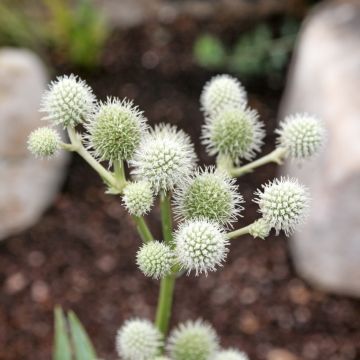
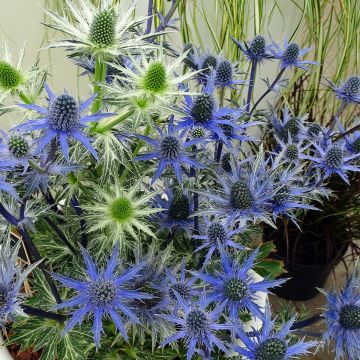
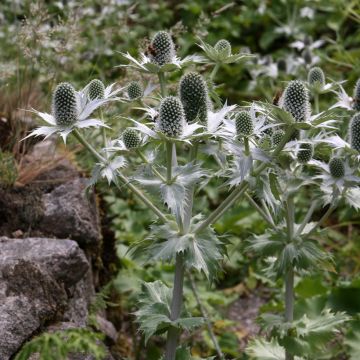
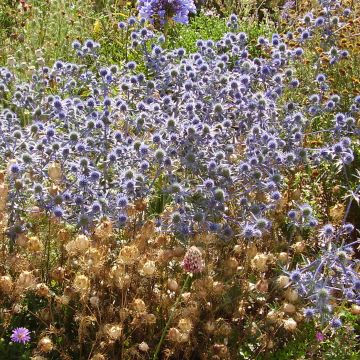
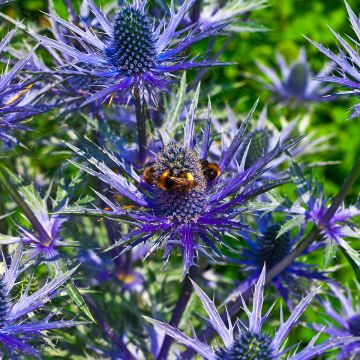

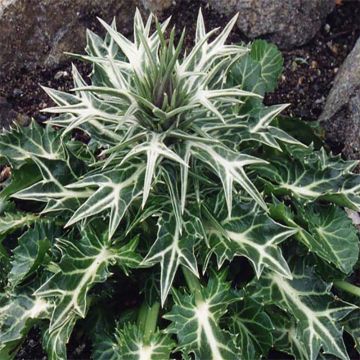
Comments